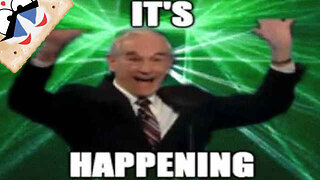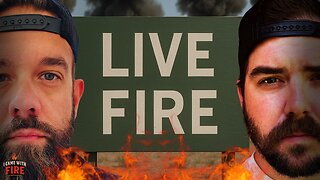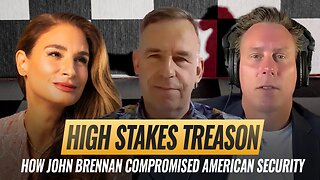Premium Only Content

All Wars Are Bankers’ Wars - How private bankers have imposed their system of slavery on the world
BY RHODA WILSON ON OCTOBER 10, 2023
WOW Another eye-opening video which bucks the "Mockingbird" Media narrative
Michael Rivero’s 2016 article and the video made from it set out the history of the last 260 years showing the effects of efforts by private bankers to impose their system of slavery on the world.
The Federal Reserve Act forced that system on the American people while the post-WW2 Bretton-Woods agreement forced it onto the rest of the world.
To keep their schemes going, these modern-day slavers do and have resorted to assassination and war to force the world to conduct all commerce only using bank notes borrowed at interest from the bankers.
This is a mafia-like practice of taking a “piece of the action” of all economic activity in exchange for little more than ink and paper – and the correct bribes to the correct officials.
The video, made by Zane Henry Productions, was written and narrated by Michael Rivero.
If the video above is removed from YouTube, you can watch it on Bitchute HERE.
Let’s not lose touch…Your Government and Big Tech are actively trying to censor the information reported by The Exposé to serve their own needs. Subscribe now to make sure you receive the latest uncensored news in your inbox…
TYPE YOUR EMAIL…
Type your email…
SUBSCRIBE
The following are excerpts from the article ‘All Wars Are Bankers’ Wars’ by Michael Rivero published on 2 July 2016
I know many people have a great deal of difficulty comprehending just how many wars are started for no other purpose than to force private central banks onto nations, Michael Rivero wrote and gave some examples “so that you understand why the US Government is mired in so many wars against so many foreign nations.”
The United States fought the American Revolution primarily over King George III’s Currency act, which forced the colonists to conduct their business only using printed bank notes borrowed from the Bank of England at interest.
After the revolution, the new United States adopted a radically different economic system in which the government issued its own value-based money, so that private banks like the Bank of England were not siphoning off the wealth of the people through interest-bearing bank notes. The US Government actually took steps to keep the bankers out of the new government. But bankers are nothing if not dedicated to their schemes to acquire your wealth and know full well how easy it is to corrupt a nation’s leaders.
First Bank of the United States
Just one year after Mayer Amschel Rothschild had uttered his infamous “Let me issue and control a nation’s money and I care not who makes the laws“, the bankers succeeded in setting up a new Private Central Bank called the First Bank of the United States, largely through the efforts of the Rothschild’s chief US supporter, Alexander Hamilton.
Founded in 1791, by the end of its twenty-year charter the First Bank of the United States had almost ruined the nation’s economy while enriching the bankers. Congress refused to renew the charter and signalled their intention to go back to a state-issued value-based currency on which the people paid no interest at all to any banker. This resulted in a threat from Nathan Mayer Rothschild against the US Government, “Either the application for renewal of the charter is granted, or the United States will find itself involved in a most disastrous war.” Congress still refused to renew the charter for the First Bank of the United States.
The British Prime Minister at the time, Spencer Perceval was adamantly opposed to war with the United States. Spencer Perceval was assassinated and replaced by Robert Banks Jenkinson who was fully supportive of a war to recapture the colonies.
Financed at virtually no interest by the Rothschild-controlled Bank of England, Britain then provoked the War of 1812 to recolonise the United States and force them back into the slavery of the Bank of England, or to plunge the United States into so much debt they would be forced to accept a new private central bank. And the plan worked.
Even though the War of 1812 was won by the United States, Congress was forced to grant a new charter for yet another private bank issuing the public currency as loans at interest, the Second Bank of the United States.
Second Bank of the United States
Andrew Jackson succeeded in blocking the renewal of the charter for the Second Bank of the United States. Following the loss of its charter, the Second Bank of the United States tried to operate as a normal bank but failed after just 5 years.
Two successive presidents opposed a private central bank, President Zachary Taylor and President James Buchanan. Both men were victims of poisoning. The first died and the second survived.
When the Confederacy seceded from the United States, the bankers once again saw the opportunity for a rich harvest of debt and offered to fund Lincoln’s efforts to bring the South back into the union, but at 30% interest. Abraham Lincoln remarked that he would not free the black man by enslaving the white man to the bankers and using his authority as President, issued a new government currency, the greenback. This was a direct threat to the wealth and power of the central bankers, who quickly responded.
In 1872 New York bankers sent a letter to every bank in the United States, urging them to fund newspapers that opposed government-issued money – Lincoln’s greenbacks. Goaded by the private bankers, much of Europe supported the Confederacy against the Union, with the expectation that victory over Lincoln would mean the end of the greenback. France and Britain considered an outright attack on the United States to aid the confederacy but were held at bay by Russia.
Left free of European intervention, the Union won the war, and Lincoln announced his intention to go on issuing greenbacks. Following Lincoln’s assassination, the greenbacks were pulled from circulation and the American people were forced to go back to an economy based on bank notes borrowed at interest from the private bankers.
With the end of Lincoln’s greenbacks, the US could no longer create its own interest-free money and was manipulated during the term of President Rutherford B. Hayes into borrowing from the Rothschilds’ banking system in 1878, restoring to the Rothschilds control of the US economy they had lost under Andrew Jackson.
James A. Garfield was elected President in 1880 on a platform of government control of the money supply. Garfield was shot on 2 July 1881 and died of his wounds several weeks later.
In 1896, William McKinley was elected President. He favoured gold-backed currencies and a balanced government budget which would free the public from accumulating debt. McKinley was shot by an out-of-work anarchist on 14 September 1901, succumbing to his wounds a few days later.
Aldrich Plan
In 1910, Senator Nelson Aldrich, Frank Vanderlip of National City (Citibank), Henry Davison of Morgan Bank, and Paul Warburg of the Kuhn, Loeb Investment House met secretly on Jekyll Island, Georgia, to formulate a plan for a US central bank, and created the Aldrich Plan, which called for a system of fifteen regional central banks, openly and directly controlled by Wall Street commercial banks. These banks would have the legal ability to create money out of thin air and represented an attempt to create a new Bank of the United States.
Due to the intense public opposition to the Aldrich Plan, the measure was defeated in the House of Representatives in 1912. One year later the bankers would be back.
Third Bank of the United States – The Federal Reserve
In 1913, the Private Central Bankers of Europe – in particular the Rothschilds of Great Britain and the Warburgs of Germany – met with their American financial collaborators once again on Jekyll Island, Georgia to form a new banking cartel with the express purpose of forcing the United States to accept a private central bank, with the aim of placing complete control of the United States money supply once again under the control of private bankers. Owing to hostility over the previous banks, the name was changed from the Third Bank of the United States to “The Federal Reserve.” It is a privately owned bank, no more “Federal” than Federal Express.
Later that same year, and apparently unwilling to risk another questionable amendment, Congress passed the Federal Reserve Act over the Christmas holiday in 1913, while members of Congress opposed to the measure were at home. President Woodrow Wilson signed it as he promised the bankers that he would in exchange for generous campaign contributions.
The next year, World War One started, and it is important to remember that before the creation of the Federal Reserve, there was no such thing as a world war.
World Wars
World War I
Although the war started between Austria-Hungary and Serbia, it quickly shifted to focus on Germany, whose industrial capacity was seen as an economic threat to Great Britain.
Although pre-war Germany had a private central bank, it was heavily restricted and inflation kept to reasonable levels. Under government control, investment was guaranteed to internal economic development, and Germany was seen as a major power. So, in the media of the day, Germany was portrayed as the prime opponent of World War I.
Following the Treaty of Versailles, a peace treaty ending the state of war between Germany and most of the allied powers, Germany was ordered to pay the war costs of all the participating nations, even though Germany had not actually started the war. This amounted to three times the value of all of Germany itself. Germany’s private central bank, to whom Germany had gone deeply into debt to pay the costs of the war, broke free of government control and massive inflation followed – mostly triggered by currency speculators – permanently trapping the German people in endless debt.
World War II
When the Weimar Republic collapsed economically, it opened the door for the National Socialists to take power. Their first financial move was to issue their own state currency which was not borrowed from private central bankers. Once again, Germany’s industrial output became a threat to Great Britain.
Germany’s state-issued value-based currency was also a direct threat to the wealth and power of the private central banks. As early as 1933 they started to organise a global boycott against Germany to strangle this upstart ruler who thought he could break free of private central bankers.
As had been the case in World War I, Great Britain and other nations threatened by Germany’s economic power looked for an excuse to go to war, and as public anger in Germany grew over the boycott, Hitler foolishly gave them that excuse.
Bretton Woods
Towards the end of World War II, when it became obvious that the allies were going to win and dictate the post-war environment, the major world economic powers met at Bretton Woods in July 1944 and hammered out the Bretton Woods agreement for international finance. The British Pound lost its position as the global trade and reserve currency to the US dollar (part of the price demanded by Roosevelt in exchange for the US entry into the war). Absent the economic advantages of being the world’s “go-to” currency, Britain was forced to nationalise the Bank of England in 1946.
Executive Order 11110
President, John F. Kennedy understood the predatory nature of private central banking. He understood why Andrew Jackson fought so hard to end the Second Bank of the United States. So, Kennedy wrote and signed Executive Order 11110 which ordered the US Treasury to issue a new public currency, the United States Note. Five months later John F. Kennedy was assassinated and the United States Notes were pulled from circulation and destroyed. Kennedy’s EO 11110 has never been repealed and is still in effect, although no modern President dares to use it. Almost all of the current national debt has been created since 1963.
Wilderness Zones and the Petrodollar
The nations that ratified Bretton Woods did so on two conditions. One of the conditions was that the US dollar would always be convertible to gold at $35 per ounce.
By 1966, the IMF estimated foreign central banks held $14 billion US dollars, however, the United States had only $3.2 billion in gold to redeem those paper notes. So, on 15 August 1971, Richard Nixon “temporarily” suspended the gold convertibility of the US Federal Reserve Notes. This move effectively ended Bretton Woods and many global currencies started to delink from the US dollar.
(Related: Canada, United States, British Empire and a New World Order and Did the Bilderberg Group orchestrate the 1973 oil crisis?)
Foreign nations began to get very nervous about their loans to the US and understandably were reluctant to loan any additional money to the United States without some form of collateral. So, Richard Nixon started the environmental movement, with the Environmental Protection Agency (“EPA”) and its various programs – such as “wilderness zones,” “roadless areas,” “heritage rivers” and “wetlands” – all of which took vast areas of public lands and made them off limits to the American people who were technically the owners of those lands.
But Nixon had little concern for the environment and the real purpose of this land grab under the guise of the environment was to pledge those pristine lands and their vast mineral resources as collateral on the national debt.
With open lands for collateral already in short supply, the US Government embarked on a new program to shore up sagging international demand for the dollar. The United States approached the world’s oil-producing nations, mostly in the Middle East, and offered them a deal.
In exchange for only selling their oil for dollars, the United States would guarantee the military safety of those oil-rich nations. The oil-rich nations would agree to spend and invest their US paper dollars inside the US, in particular in US Treasury Bonds, redeemable through the slave labour of future generations of US taxpayers. The concept was labelled the “petrodollar.” In effect, the US, no longer able to back the dollar with gold, was now backing it with oil. Other peoples’ oil. And that necessity to keep control over those oil nations to prop up the dollar has shaped America’s foreign policy in the region ever since.
Iraq, already hostile to the United States following Desert Storm, demanded the right to sell their oil for Euros in 2000. In 2002, the United Nations agreed to allow it under the “Oil for Food” programme. One year later the US re-invaded Iraq under the lie of Saddam’s nuclear weapons, lynched Saddam Hussein, and placed Iraq’s oil back on the world market only for US dollars.
Over in Libya, Muammar Gaddafi had instituted a state-owned central bank and a value-based trade currency, the Gold Dinar. Gaddafi announced that Libya’s oil was for sale but only for the Gold Dinar. Other African nations, seeing the rise of the Gold Dinar and the Euro, even as the US dollar continued its inflation-driven decline, flocked to the new Libyan currency for trade. This move had the potential to seriously undermine the global hegemony of the dollar.
So, the United States invaded Libya, brutally murdered Qaddafi, imposed a private central bank and returned Libya’s oil output to dollars only. The gold that was to have been made into the Gold Dinars, 144 tonnes of it, is, as of the last report, unaccounted for.
Emails surfacing as part of the investigation into Hilary Clinton‘s use of a private email server for classified information confirmed that the real reason for the US invasion of Libya was to destroy the threat of the Gold Dinar becoming a pan-African currency, displacing the dollar. (See Wikileaks Hillary Clinton Email Archive.)
According to General Wesley Clark, the master plan for the “dollarification” of the world’s oil nations included seven targets, Iraq, Syria, Lebanon, Libya, Somalia, Sudan and Iran. Venezuela, which dared to sell its oil to China for the Yuan, is a late addition.
What is notable about the original seven nations targeted by the US is that none of them are members of the Bank for International Settlements, the private central bankers’ private central bank located in Switzerland. This meant that these nations were deciding for themselves how to run their nations’ economies rather than submit to the international private banks.
-
 2:22:32
2:22:32
FactualNewsandInterviews
1 year agoCalley & Casey Means Explain Big Pharma Big Food and how they POISON us.
182 -
 2:15:23
2:15:23
TheSaltyCracker
3 hours agoFinally Someone Gets Raided ReEEeStream 8-22-25
34.4K124 -
 LIVE
LIVE
I_Came_With_Fire_Podcast
15 hours agoChina's New Ship Killers, EU Dead, Shooter HOAX, and The Missing Woman
158 watching -
 LIVE
LIVE
SynthTrax & DJ Cheezus Livestreams
11 hours agoFriday Night Synthwave 80s 90s Electronica and more DJ MIX Livestream OUTSIDERZ Edition
146 watching -
 LIVE
LIVE
VapinGamers
2 hours agoFortnite Friday with BrianZGame and Community! #1 Controller Scrub NA - !rumbot !music
62 watching -
 LIVE
LIVE
iCheapshot
2 hours agoTrying Out The Finals | Complete Newb
25 watching -
 LIVE
LIVE
HogansAlleyHero
4 hours ago💥2XP WEEKEND - BF6 REWARDS UNLOCK GRIND 💥
9 watching -
 1:11:19
1:11:19
The Mel K Show
4 hours agoMel K w/ Ian Trottier & John Donovan | High Stakes Treason: How John Brennan Compromised American Security for Millions | 8-22-25
12.9K9 -
 LIVE
LIVE
megimu32
3 hours agoOFF THE SUBJECT: FAFO Friday! Shure GIVEAWAY!
194 watching -
 LIVE
LIVE
AlaskanBallistics
1 hour ago $0.01 earnedI Love This Gun Podcast #61
149 watching